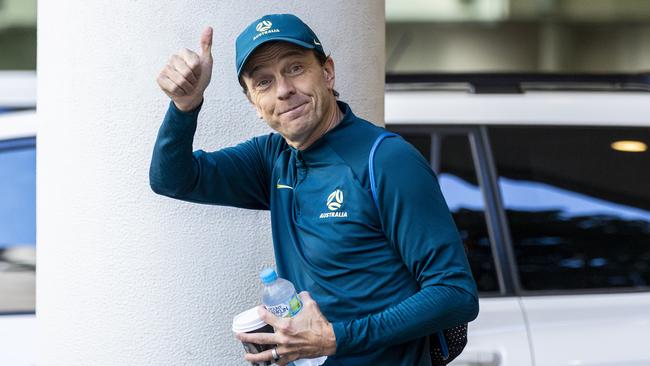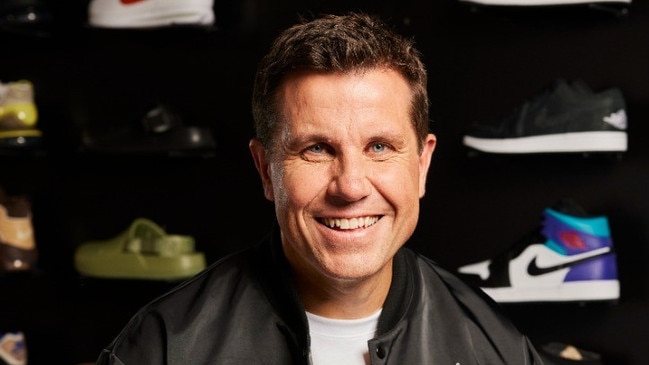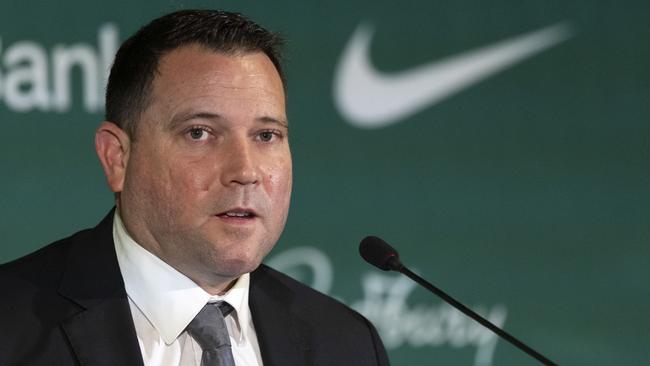Football Australia lobbies Anthony Albanese for $500m grassroots funding
Buoyed by the Matildas’ stunning success, soccer officials are pushing the Albanese government to provide $500m for community facilities, leading to a showdown with the AFL and Brisbane Olympics for funding.

It is the $500m dream the Matildas could make come true, as soccer takes on the richest football codes and the 2032 Olympics in the sport funding wars.
Soccer officials, buoyed by the stunning success of the Women’s World Cup and the Australian team’s charge into the quarter-finals, have been pushing the Albanese government hard to provide $500m in funding for a “community facilities fund”.
The rise of the Matildas has lifted the code and put it in a head-on funding clash with the sporting giants in the lead-up to the 2032 Brisbane Games, particularly the AFL.
If $500m sounds a lot, compare it with the $240m the Albanese government has promised for a controversial $715m Hobart stadium for the AFL, already the richest sport in the country.
The AFL will provide just $15m, although it has also said it will give $343m over a decade to develop the team and the game in Tasmania.
For Football Australia bosses, the dream is to cash in on the unprecedented interest in women’s sport – which seems to have caught the federal government by surprise – and inject much-needed funds in paying for decent fields and change rooms for the girls and boys who already are or want to play soccer as a result of watching heroes such as Mary Fowler and Hayley Raso win matches for the Matildas at the World Cup.
They will have to try to outmanoeuvre the AFL, which is an astonishingly smart player in the funding realm despite being financially cushioned by a $1bn TV rights deal.
In recent years the AFL has been awarded $30m in grants for new AFLW facilities for both the Sydney Swans and Carlton football clubs. Earlier this month the AFL NT was awarded $4.7m to promote football in the community.
But Football Australia is projecting a 20 per cent increase in young girls and women player numbers after the World Cup, and there is a dire need for ground upgrades and spending on female change rooms and other facilities.
Football Australia chief executive James Johnson, who took FIFA global boss Gianni Infantino to meet Anthony Albanese at Parliament House last week, says the Matildas brand is just about the biggest thing in Australian sport right now.
The brand had already exploded in popularity over the past three years, with blue-chip sponsors such as Commonwealth Bank (also a World Cup sponsor), Qantas, Lego, Nike, Cadbury, Priceline and Spanish car company Cupra paying up to be associated with the Matildas.
Johnson says Football Australia still has Matildas’ sponsorship categories to sell in the insurance, logistics and technology sectors, and its sleeve-sponsor contract, currently held by Seven Consulting, is up for renewal next year. “When it’s easy to fill Stadium Australia and get 75,000-76,000 people to a Matildas match, where you don’t have enough supply for the demand, you know you’ve got a good product,” Johnson says.

He points out that Matildas shirt sales are already double those of Socceroos tops during last year’s men’s World Cup.
“When we‘re seeing broadcast numbers like a 3.5 million average audience, you know you have got a good brand,” he says. “And with a total (broadcast) reach (against Denmark last Monday) of 6.5 million then that’s 25 per cent of the population. The brand was heading north and I think its just gone up to another level during the World Cup.”
What money can’t buy is genuine, deep-seated support for a code or team – and the Matildas have easily captured the nation’s hearts.
Such has been the huge ratings for free-to-air broadcaster Seven Network that if the Matildas’ clash against France on Saturday evening goes into extra time then the AFL game between high-flying Carlton and Melbourne will be relegated to one of Seven’s secondary channels.
In 2000, eight million Australians watched Cathy Freeman’s victory in the 400m at the Sydney Olympics. The 2003 Rugby World Cup final, when England’s Jonny Wilkinson sunk the hearts of Australia, drew in four million. Then two years later 5.7 million watched Lleyton Hewitt lose the Australian Open tennis final to Marat Safin. Ash Barty last year won the Australian Open and attracted an audience that peaked at 4.3 million.
When it comes to team sports, there is every chance the rugby World Cup final record could be eclipsed on Saturday evening.
One of Australia’s leading sports and media rights experts, Colin Smith, says: “It could be the most watched event for not only 2023 and perhaps one of the highest ever.”
So who’s watching the Matildas? There is a little bit of return to the couch on this, with families watching this together, which is not what you’d say is the norm in 2023. “You know, you’ll see Gen Z watching it on their mobiles, etc, but this is really a family, more family experience than ever before.”
Then there are those packing out pubs and watching the Matildas and, if you are lucky enough, in the Stadium Australia stands. Former Matilda Heather Garriock says it’s the “electric” crowds that have blown her mind.
Never in her wildest dreams did she think she’d see an Australian women’s soccer team packing out stadiums with fans screaming their lungs out.

Garriock stood on the sideline taking in the atmosphere of the crowd at Stadium Australia in her role as a commentator for Seven last Monday. Days on she was still stunned by it all.
“It’s just a dream,” says Garriock, who appeared 130 times for the Matildas from 1999 to 2011.
“I just never thought I’d ever see it and I’d never even had that in my mind for this to be able to occur. It was building and it has been building, but not to this magnitude.”
Garriock notes she played in an era when crowds were sometimes made up of hundreds of diehards and family and friends, and in a time when they often returned home in debt from international tours.
However, she says she would do it all over again and is heartened by the fact that both women and men’s national teams are now paid equally by FA.
“When I first came into the national team, it was for the love of the jersey – and I am not saying they don’t love the jersey as much as what I did or what other past players did – but back then you did it for the passion and the love because there was no financial remuneration and, in fact, it probably came at a cost,” Garriock says.
“But you are there to represent your country, to proudly sing the national anthem before the game; for nothing. And, you know, I’m still sitting here grateful for the moments I shared with my Aussie teammates and what I signed up for. But seeing where we’re at now and seeing our Matildas and professional superstars, you know, bring in crowds of 80,000, it’s just incredible.”
When asked why the Matildas are resonating with the public, Garriock says it is because the team has an overwhelming quality of “humility”. The team also has a determination to be “connected” to the fan base.
She says it is important to understand that the core players on the team haven’t been professional for long.
“The core group of players, who’ve been part of this team over the last 10-odd years in the Matildas have come from a semi-professional environment, which is a similar environment to what I just spoke to,” Garriock says.
“Now they are playing in a fully professional environment and they are appreciating every moment – the girls have got that really humble, connected personality and they want to connect to the fans. I think that’s a real point of difference with this team … they’ve evolved to here.”
Johnson echoes Garriock’s point that this is a team “connected” to its fans.
“The amount of people that are talking about how they feel better connected to the community and to Australia through the Matildas, and for me that’s something that goes beyond KPIs and beyond broadcast numbers and attendances,” Johnson says.
“When you’ve got a country that can feel connected through a sporting brand then it is unchartered territory and it is just absolutely brilliant.”
According to one source, Matildas merchandise is outselling that of national cricket and rugby union teams at venues. Football Australia has also increased the range of Matildas gear beyond the usual scarves, shirts and beanies.
Stores such as Smiggles sell children’s pencil cases and other gear and on The Iconic online store $109 Matildas gift sets are for sale – categories the brand has never had before.
Nike Pacific vice-president Ashley Reade says there is a demand for the Australian team’s jerseys like never before.
“In fact, there were more jerseys sold before a ball was even kicked in this year’s tournament than were sold pre, during and post the 2022 men’s tournament,” Reade says.
“It’s a true testament to the power and excitement surrounding the women’s game and reflects the unparalleled impact this team has had on the next generation of athletes and fans of all ages.

“The Matildas have inspired a nation. It has been amazing to witness a sea of gold and bright turquoise in the stadium crowds, on the streets and in homes as momentum builds behind this incredible team.”
Research released by the Victorian government in its The Value of You Can be What You Can See report pre-tournament suggests that every $1 spent by a corporate sponsor of elite women’s sport supports the realisation of $7.29 in customer value to that business.
That competitive advantage from the sponsorship included, the report said, a bigger rise in brand awareness, brand consideration and customer conversation about a particular product than a similar deal for a men’s sport.
“You’ve got partners like our existing ones … that are coming in and putting the right number on the table because of where the brand is,” Johnson says.
“After the Women‘s World Cup, it will grow, but our view is that the companies already there with us and potential sponsors that want to be part of it have to pay the right amount, because it is a real commercial sports brand. We’ve gone beyond the point of people investing in it because it’s ‘the right thing to do’. This is a commercial brand now. It’s very strong, and I do believe it’s as strong as probably just about any in the country.”
There has been talk of a public holiday if the Matildas win the World Cup – but those in the know say that won’t cut it.
As former Matildas captain Melissa Barbieri bluntly put it on social media: “Albanese keeps talking about this freaking public holiday. How about you just frucking fund our sport properly.” As she has also said, the participation rates demands change.

Johnson says soccer has been fortunate to have received about $300m in financial support from federal, state and local governments in the past few years. About one third of that has been spent on a new “Home of the Matildas” dedicated women’s soccer facility in Melbourne.
The other big sports still generally get more government attention and support, despite soccer’s huge grassroots player numbers.
Johnson says there are three main areas that would need new funding in the future.
The first is to further help with community facilities, hence the talk of the community facilities fund, and the second is high-performance given the Matildas will also try to qualify for next year’s Paris Olympics.
“The third area that we really need support for is funding to bring these big events to Australian shores,” Johnson says.
“We’re bidding right now for the women’s Asian Cup in 2026. And we’re talking about looking at a possible 2029 Club World Cup and men’s World Cup in 2034, and that requires government support and funding.
“We’ve seen what it does, not only to football, but to sport in this country.”





To join the conversation, please log in. Don't have an account? Register
Join the conversation, you are commenting as Logout